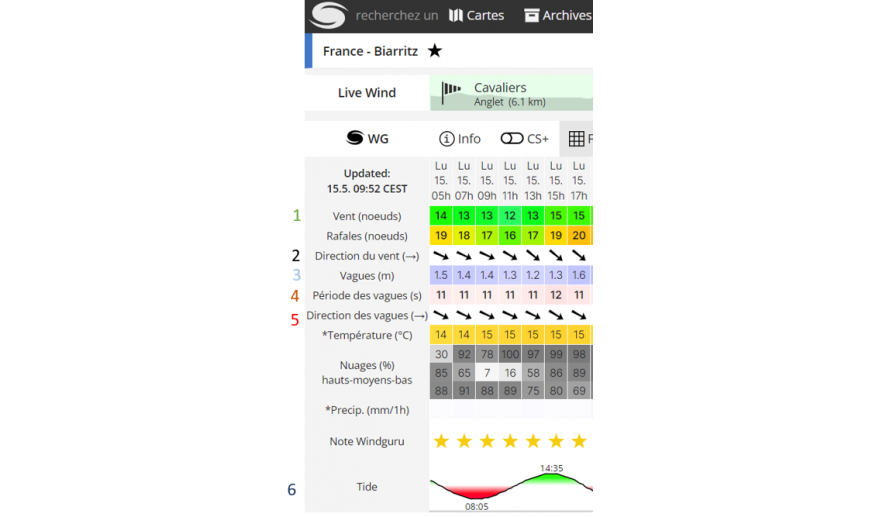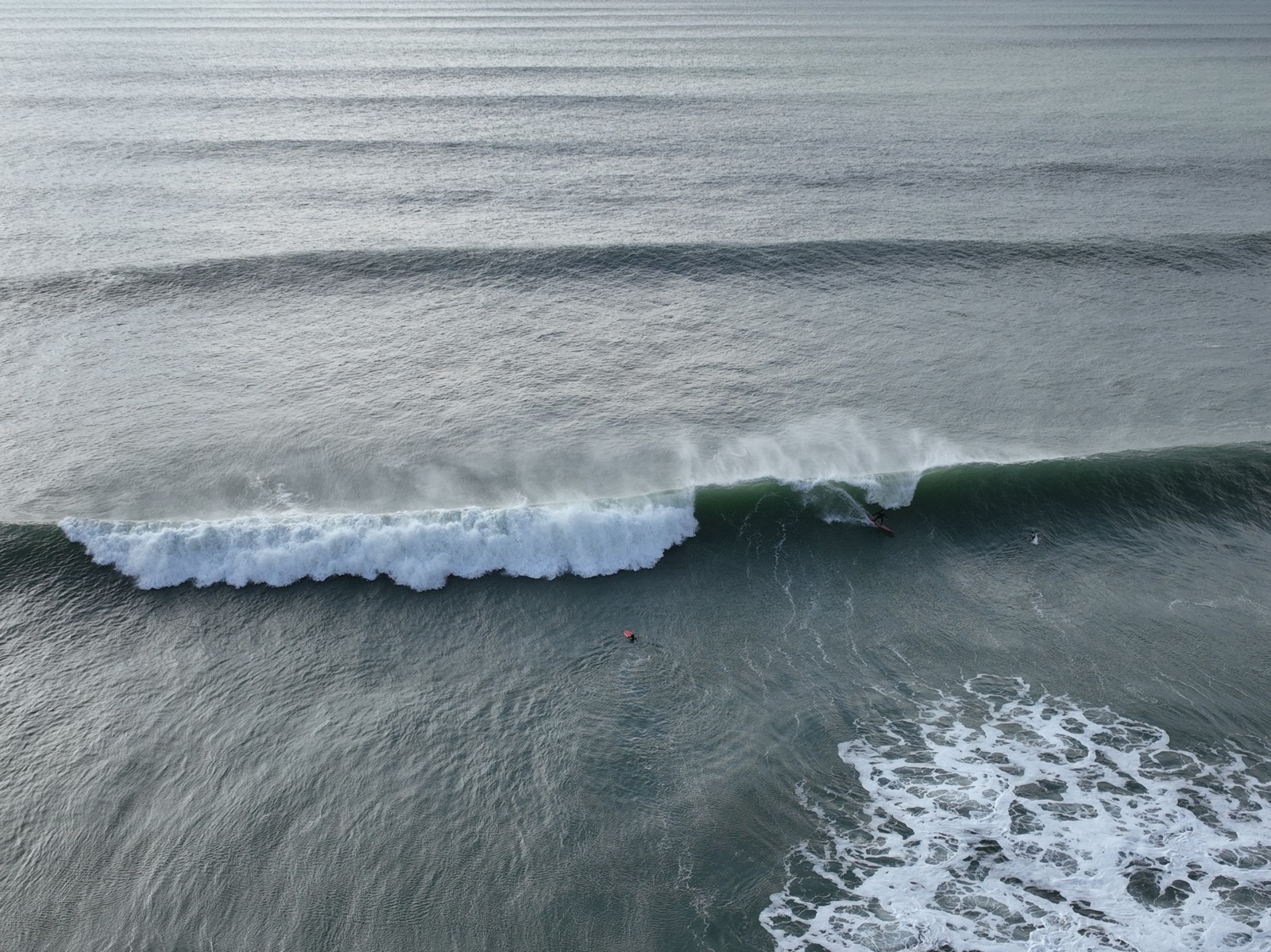How to read the surf forecast in Biarritz and the basque country

To start, we advise you to use the windguru app or website to read surf forecasts in the Basque Country.
1. Wind Strength
On Windguru, wind strength is represented by knots and by a color code.
- White/Light blue: weak wind
- Green= moderate wind
- Yellow/Orange/Red = strong wind
- Purple = storm
(One knot corresponds to 1.852 km/h (1150.7794 mph))
Example:
On Monday, at 5 am, the wind was 14 knots, represented in green, indicating a
moderate wind. Moreover, the wind gusts were 19 knots, illustrated in yellow, indicating strong gusts.
Advice:
You should not overlook the strength and direction of the wind, those are crucial
elements to better understand the conditions. If the wind is too strong, it may prevent the formation of waves, even if the predicted swell height is 1m70 meters (5’7).
2. Wind Direction
There are several types of wind :
- Offshore wind comes from land towards the ocean. It is preferable as it
helps waves formation and generally creates cleaner water with higher
waves.
> Offshore wind is represented by an arrow pointing to the left
- Onshore wind comes from the ocean towards the land. It can makes
the waves smaller, more broken, and slightly more chaotic, which lead
to a more challenging reading and a harder way to position itself.
Onshore wind is represented by an arrow pointing to the right
- Side shore the wind blows along the beach and tends to shape the waves and create sea currents
The arrows are represented from bottom to top.
Example:
In the photo, it can be seen that on Monday at 5 am, the wind was a northwest wind.
The wind direction will greatly influence waves formation, as mentioned earlier.
Advice:
To understand the wind orientation, you can imagine a picture of the Basque Coast.
The Basque beaches are in a hollow that is northwest and west, which means that a south wind will remain offshore on Basque beaches and become side shore on the Landes beaches.
3. Waves
The wave size in meters indicates the size of the swell. Be careful to not suppose
that swell directly correspond to the wave size. The wave size will fluctuate, depending
on the period and the configuration of the spots
Example :
On Monday at 5 am, there was a 1.50-meter (4”11) swell, but it doesn’t mean there were
1.50-meter waves.
4. Wave Period
The period is the time between each wave. It is measured in seconds and longer
is the period, longer the waves have to grow. This data is essential to understand the size of the waves that will be formed.
As a contrary,shorter is the period, closer the waves will be. It will be more challenging to go
offshore, and the whereas water surface will be less clean. However, the longer is the period,
the less frequent the waves will be. Nevertheless, the water surface will become
cleaner thanks to more time between waves.It’s worth noting that if the period is 15 seconds and the announced swell is 1.50 (4’11)
meters, likely, wave heights will easily reach 2 meters (6’7) during the sets.
Example :
- Period of 4-7sec = Few waves, unclean water surface
- Period of 9-10sec= Good waves, unclean water surface
- Period of 11-15sec = Very good waves, very clean water surface
- Period above 15sec = Very clean waves but the long waiting time
On Monday, we’ve had a period of 11s, indicating perfect waves with a very clean
water surface. However, as previously told, there was significant wind that
day, so the waves were not optimal.
Advice:
The majority of spots along the Basque and the Landes Coast are beach
breaks, which generally don’t handle elongated periods well.
When the period is too long, the sandbanks struggle to support the swell, resulting in
closeout waves (as seen in the photo).
Therefore, we recommend opting for reef breaks such as Guéthary or Lafitenia,
where the ocean floor is rocky, allowing them to better handle longer periods.
Reef breaks, as the name suggests, are surf spots with rocky or coral bottoms rather
than sand.

5. Wave Direction
The northwest direction is generally preferred on the Basque coast as it provides the formation of larger waves with a long swell period. This is ideal for
experienced surfers.
The west direction is also good as it enables the formation of good waves with a shorter swell period, which is preferable for beginner or intermediate surfers.
Example :
On Monday, the wave direction was northwest.
Advice:
For your information, in the Basque Country and Landes, most of
waves are oriented northwest or west. It is rare to see waves coming from other
directions.
6. Tides
Tides determine the amount of water in the ocean, which affects waves formation
and water depth at different times of the day. Generally, there are two high tides and
two low tides in a day.
Example:
On Monday at 5 am, the tide was receding and was going to reach low tide at
8.50 am
Advice:
Beginner surfers are advised to surf at low tide, as the waves will be slightly less
powerful. However, it depends on the specific spot where you decided to surf. Some
spots can only be surfed at low tide, mid tide, or high tide. Therefore, it’s important to
gather information about the spot’s behavior before moving to it, even if the conditions seem
perfects. You may be disappointed upon arriving at the spot if you haven’t looked into characteristics beforehand.






